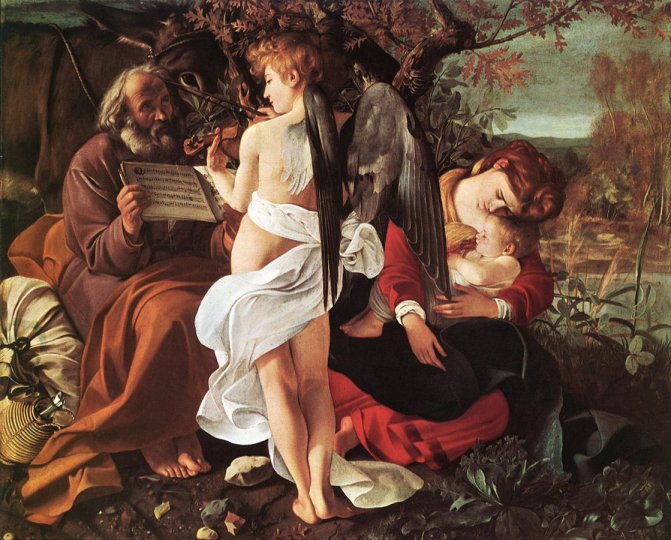|
This picture is one of the highlights of the Gallery Doria
Pamphilj in Rome, though for me the greatest painting there is Velasquez's
portrait of Pope Innocent X. This is wisely hung in a room by
itself, lest the sitter's venomous and unsettling stare should
discomfort the rather more agreeable characters in the other
paintings.
|
|
Many have commented on the almost obsessive
detail in this picture. It is a painting full of significance and hidden
secrets; I know there's a great deal more to it than I can grasp.
All I can say is that I'm working on it.
The scene shows a beautiful and (from Joseph's viewpoint) naked angel
playing a violin, with Joseph holding up a musical score for him to
follow. Mary and the Christ Child are asleep.
The figure of the angel divides the painting into two very different
halves. Joseph's half is bleak and stony - nothing grows there. Look at
the ground beneath Joseph's bare feet - walking there would not be a
comfortable experience. He rests one foot on another to gain some small
relief.
The right hand side is a complete contrast. Unusually for
Caravaggio, we see a landscape, with the sky above. The ground here
produces a range of flowers, and even the oak tree has a fungus
growing on it.. The
angel provides the transition between the paradisiacal world represented
by the Virgin, and the harsh reality of the real world represented by the
aged and weary Joseph.
The angel's nudity has been discussed at length. A contemporary cardinal,
Frederico Borromeo, declared that angelic nudity 'is
a sign of their immunity from any contamination by human misery'.
Possibly, though angels weren't usually portrayed thus. When they grew out
of putti-hood they became respectable by and large, and put
their trousers on. It also has to be said that Caravaggio wasn't
averse to a bit of homoeroticism.
The music the angel is playing has been identified, and this is one of the most
fascinating aspects of the painting. It is a setting of the Song of Solomon, a motet in C major
by the Flemish composer Noel Baulduin, published in 1519, Quam pulchra
es et quam decora ( How fair and how pleasant art thou).
Given that it's not clear how even an angel could play a motet on the
violin, it is nevertheless worth reading a little more of the text,
starting at Chapter 7 verse 6:
|
|
How fair and how pleasant art
thou, O love, for delights!
This thy stature is like to a palm tree, and thy breasts to clusters of
grapes.
I said, I will go up to the palm tree, I will take hold of the boughs
thereof:
Now also thy breasts shall be as clusters of the vine,
And the smell of thy nose like apples. |
In this context it has been used as a means to extol
the beauty of the Virgin, but there also seems to be a subtle reference to
the legend of Joseph picking fruit from the palm tree.
Scholars have scrutinised this picture with almost as much obsession as
Caravaggio painted it, and some of the scholarship seems a little
misplaced. Someone has even identified the species of fungus growing on
the tree, (It's called Trametes
versicolor if you really want to know) and there is much debate about
which other paintings the models here pop up in. What is really
interesting here is the possible concealed reference to a myth disapproved
of by the Council of Trent just thirty years before.
Can this be down to Caravaggio? Probably not. The
painting was almost certainly commissioned by a cardinal, someone with a particular
theological viewpoint, and he would have told Caravaggio precisely what to
paint, Council of Trent or no. What the cardinal couldn't do, of course, was tell him how to paint
it.
|
